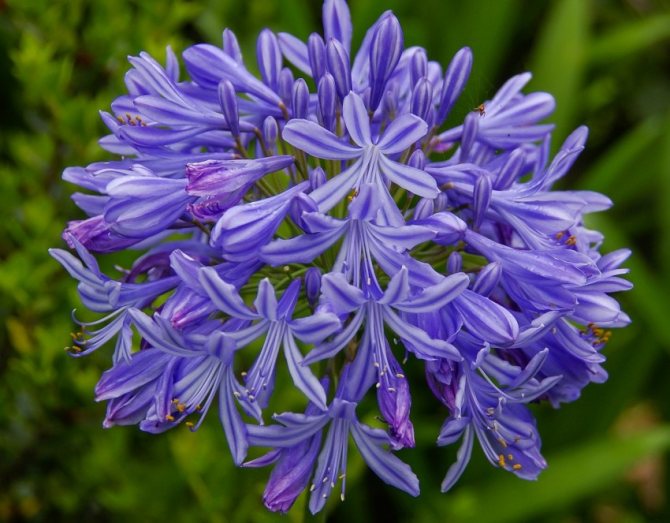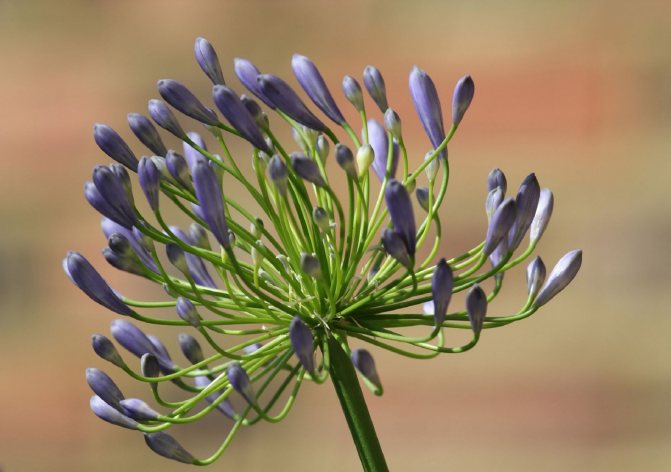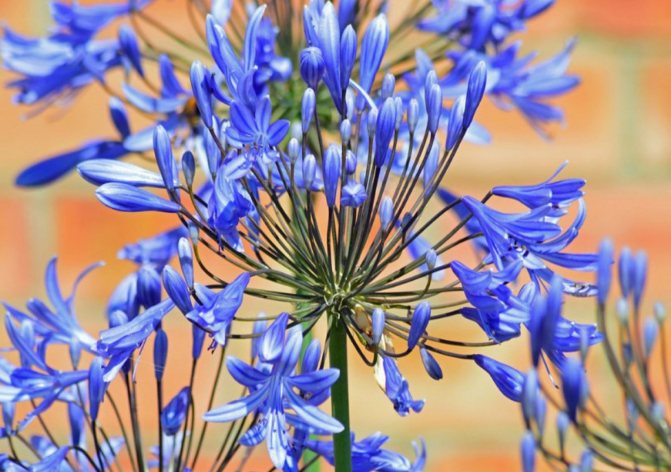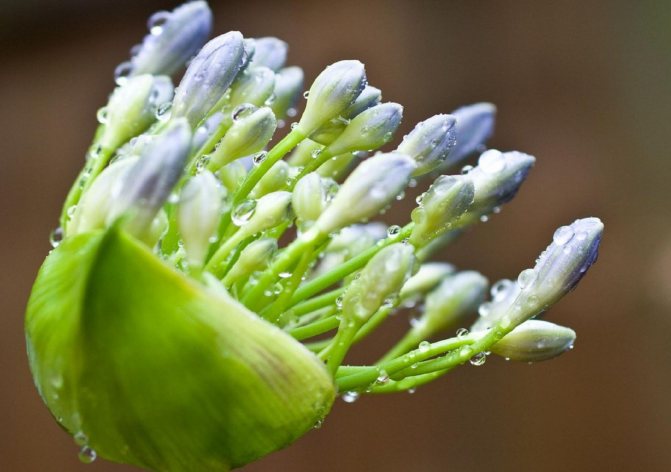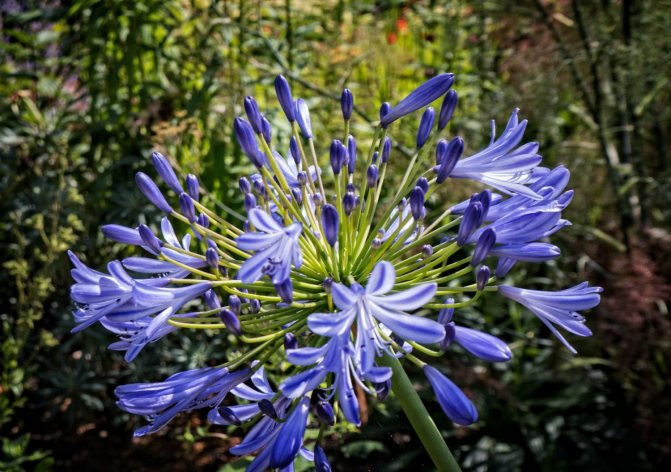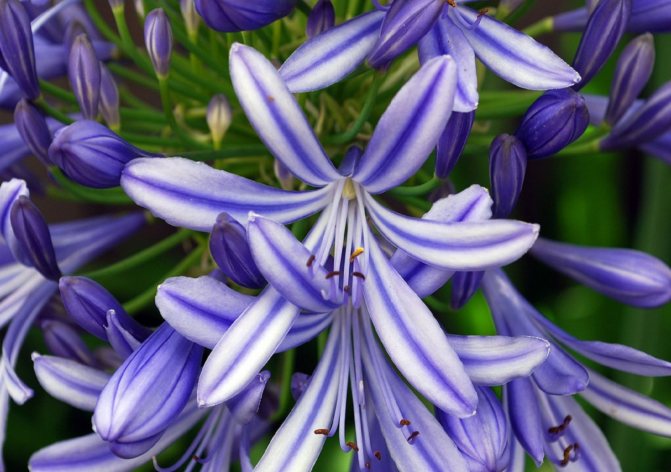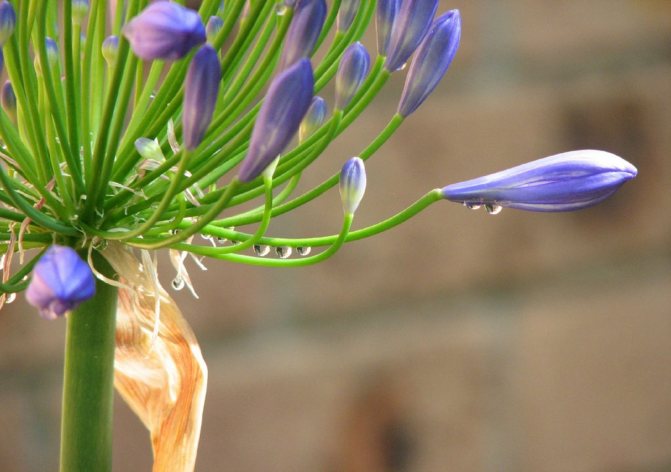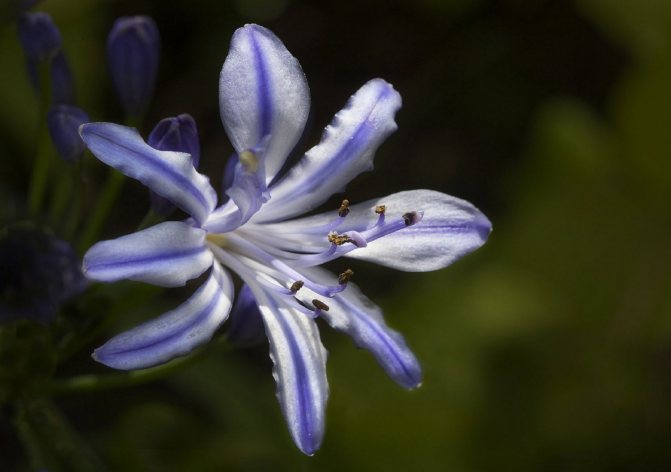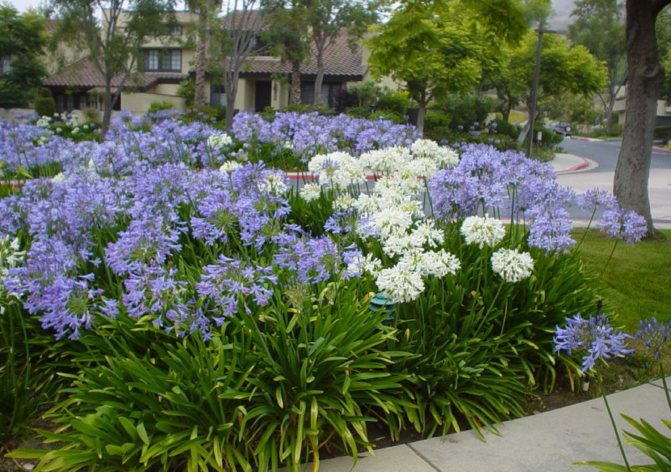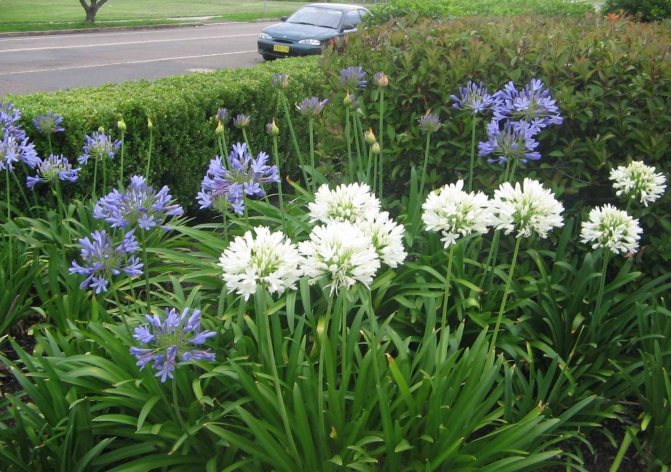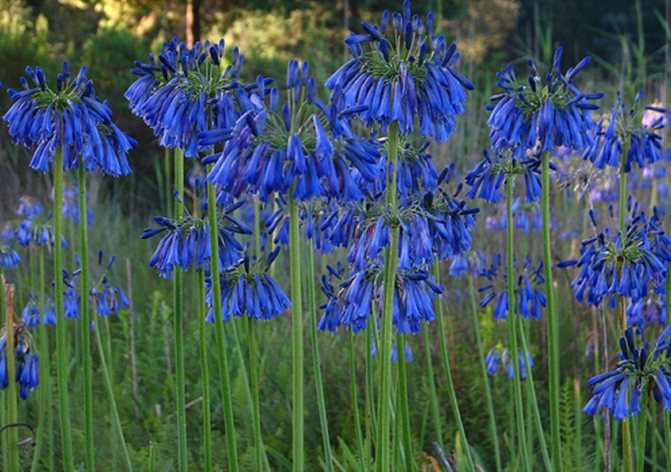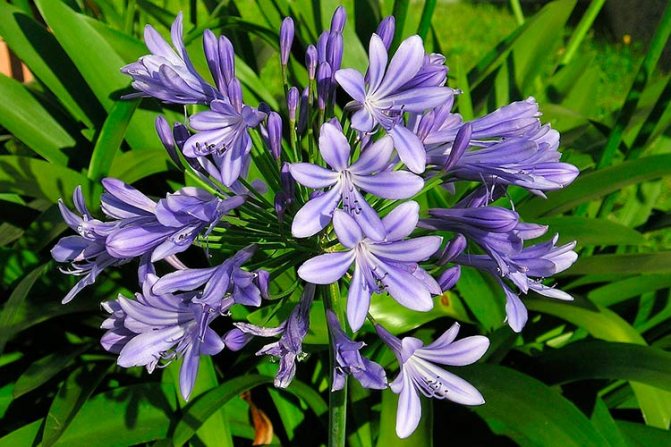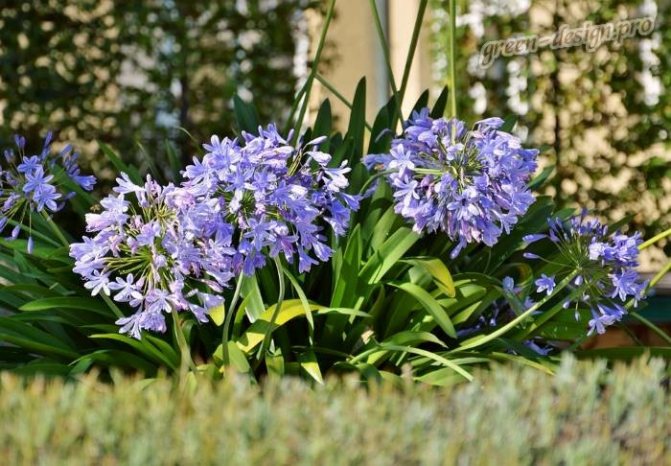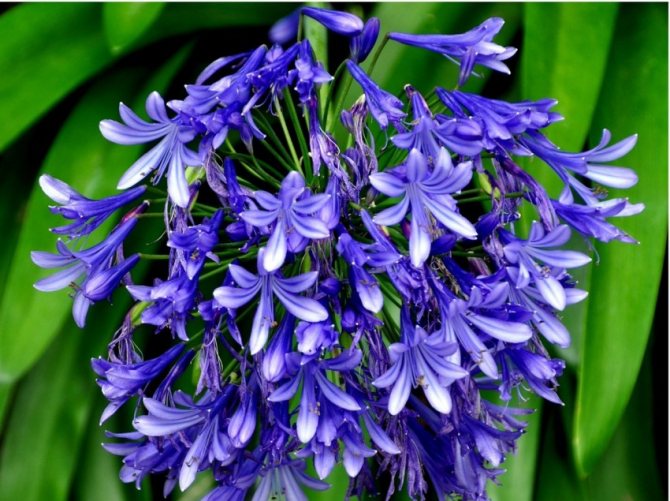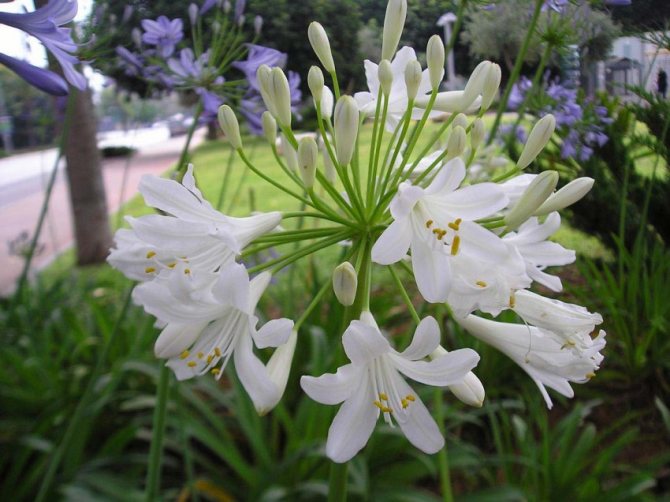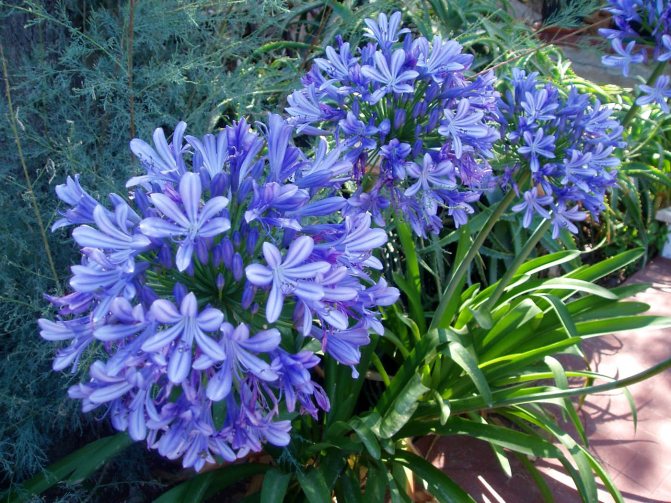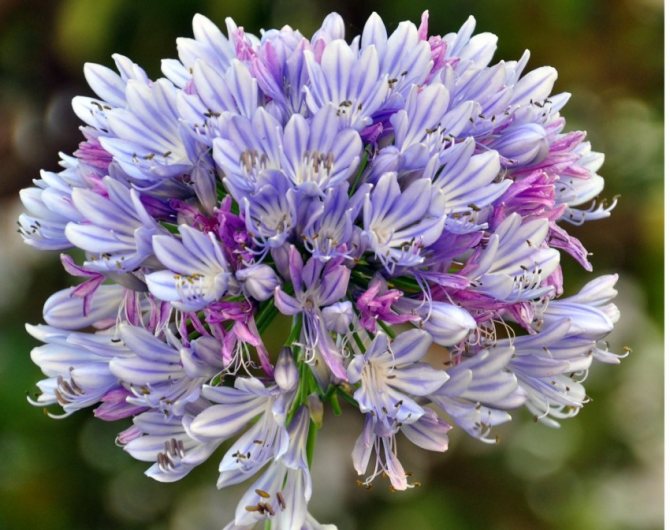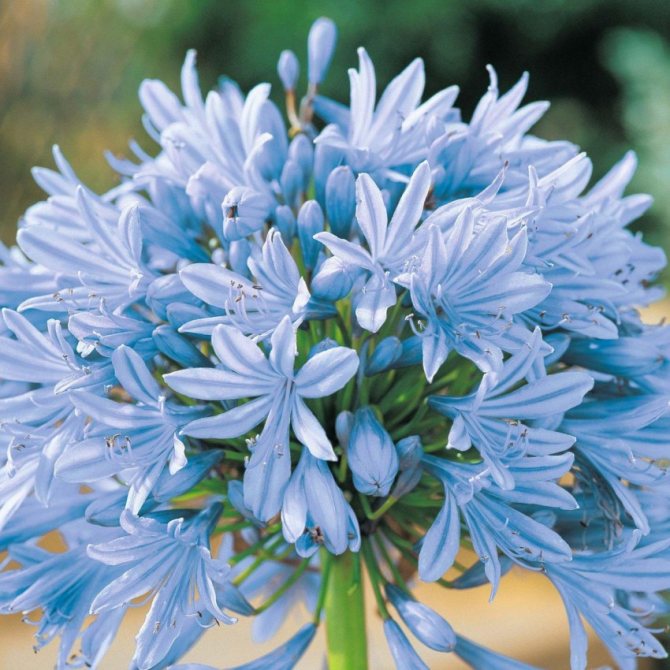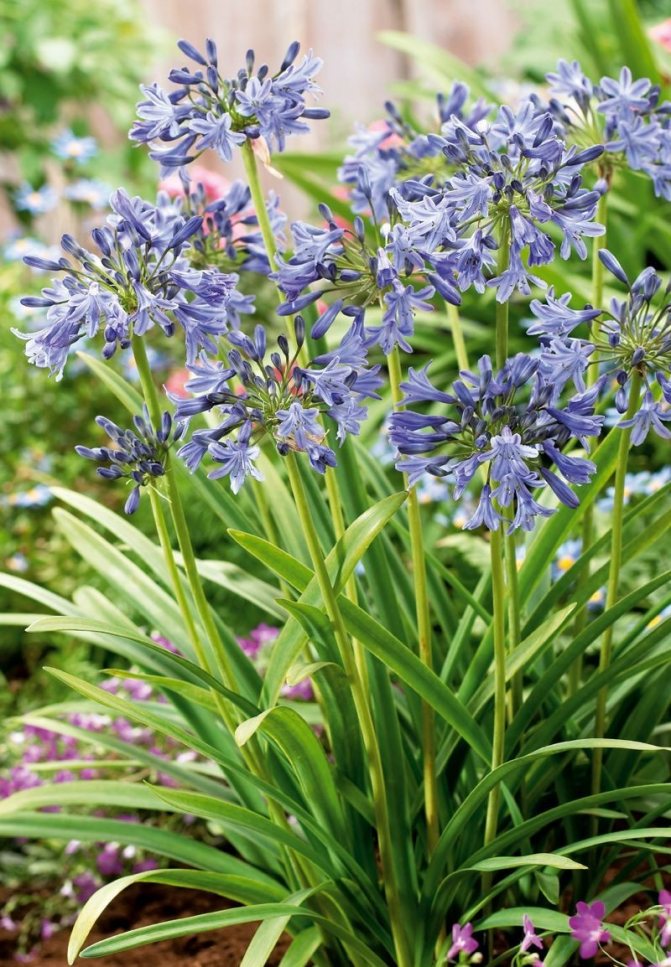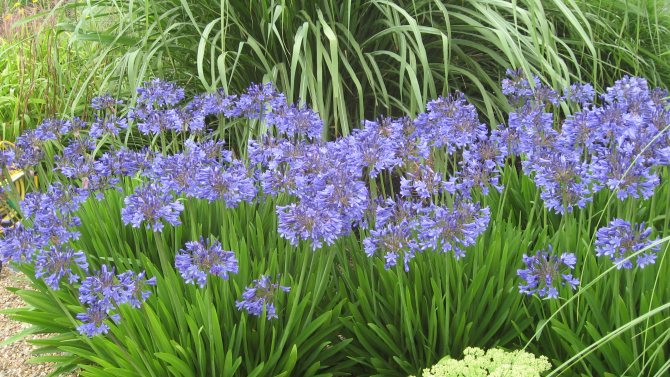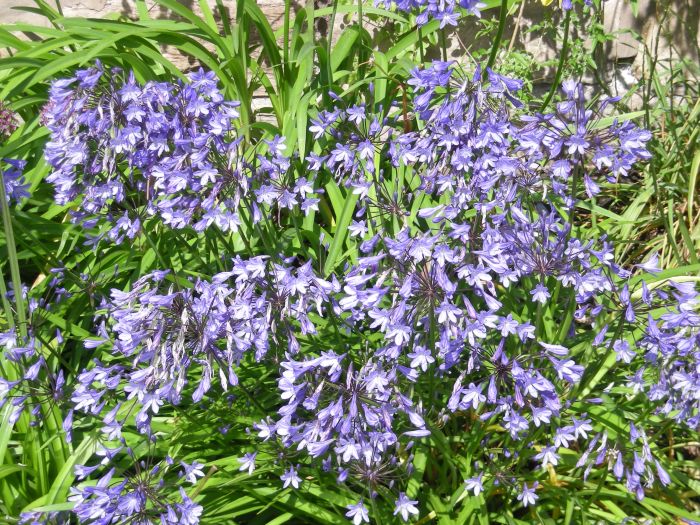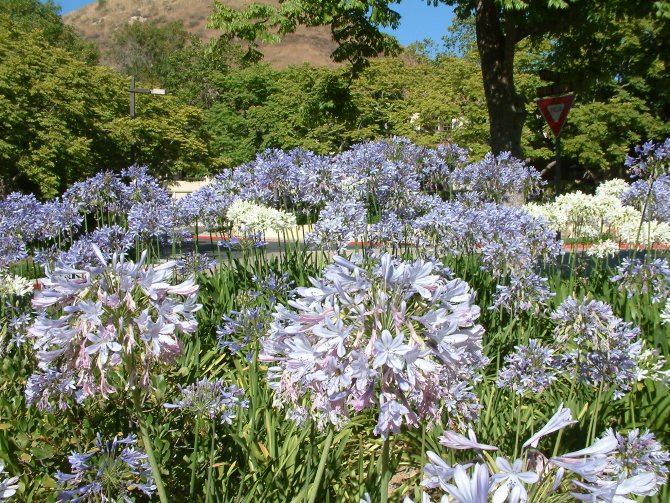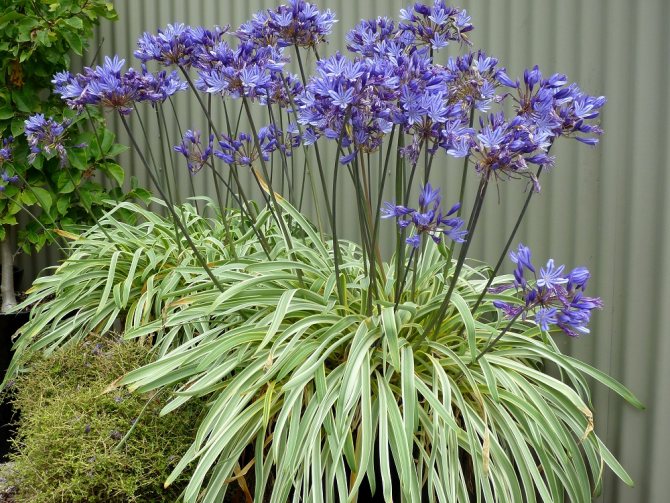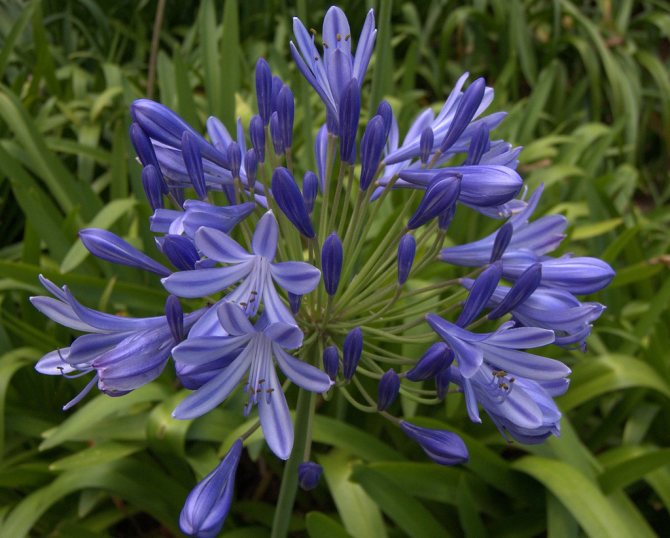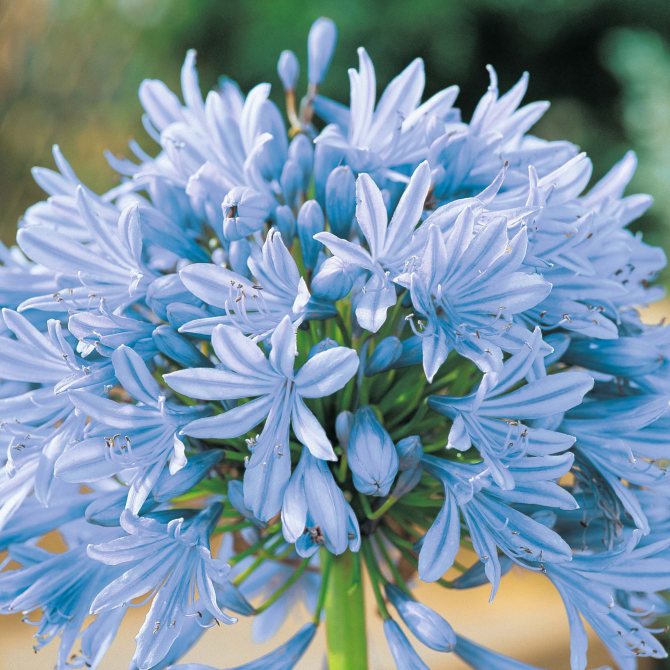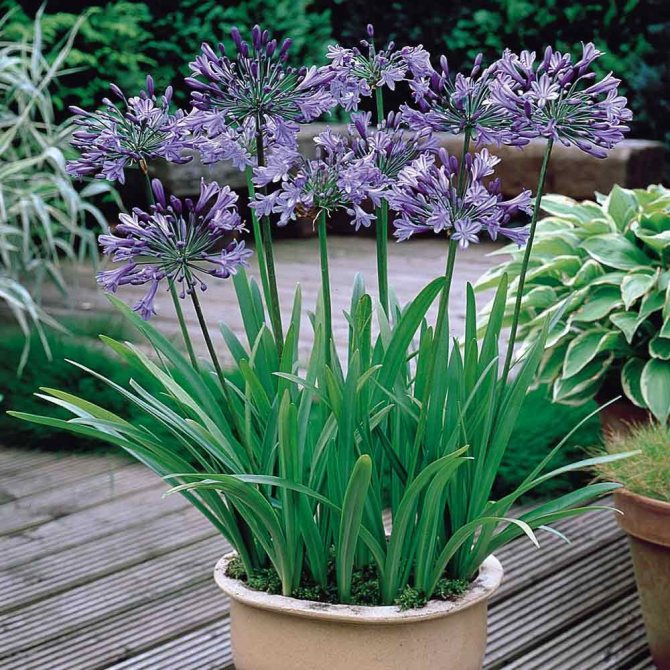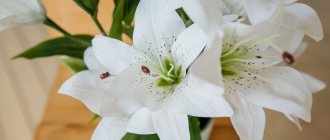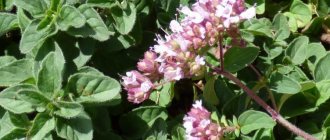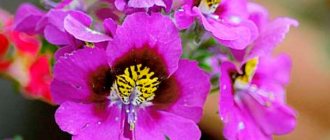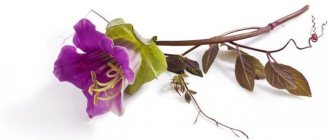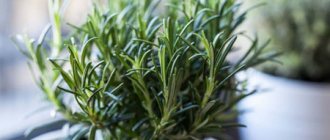Agapanthus is a delicate herbaceous perennial with bright foliage and unusual flowers. It is suitable for indoor growing, landscaping and flower arranging. Agapanthus bewitches with quivering petals of pastel shades. The plant belongs to the Agapant family. Its homeland is the vastness of Central and South Africa.
Here you will find out:
Description of the plant
Agapanthus is a plant with fleshy, highly branched roots. Most of the root mass is located in the upper soil layers. A dense rosette of leaves blooms above the surface of the earth. They are belt-shaped and dark green in color. The length of the foliage is about 50-70 cm. Even between flowering, the agapanthus forms a decorative spherical bush. In the genus agapanthus, there are evergreen and deciduous forms adapted to various living conditions.
By the beginning of summer, a fleshy peduncle with a round section grows from the center of the leaf rosette. Its height is 40-150 cm. The top of the bare peduncle is decorated with a spherical dense inflorescence up to 25 cm in diameter. Bell-shaped flowers of blue, lavender or white flowers are located on their own thin stems. The length of the bud is 5 cm. On the oval petals, a darker central stripe can be traced. Flowering continues until the end of October.
1-1.5 months after pollination of the flower, the fruit ripens - the seed capsule. It contains many flat, dark brown seeds.
Diseases and pests
There are no particular difficulties in growing these flowers, since they are rarely affected by diseases and pests.
Certain difficulties can arise only if the plant has been placed in the wrong area or is not properly looked after. For example, with excessive watering, the roots may begin to rot and the leaves may turn yellow. If the agapanthus grows in a shaded area, its peduncles will begin to stretch and may break, and you will not wait for flowering.
Of the pests, the scabbards and spider mites are the most dangerous. It is almost impossible to notice their presence on the ground, but you can determine the invasion of insects by the appearance of the leaves. They begin to dry and fall off, and before that they become covered with a characteristic sticky bloom. To cope with pests, you need to wash the leaves with soapy water, and spray the bush with insecticides.
You will find more useful information about this interesting plant in the video.
Agapanthus species in culture
The genus agapanthus is not very diverse. The plant is actively pollinated and gives a lot of interesting hybrids.
Agapanthus umbrella. The plant up to 70 cm in height is a clump of rather wide belt-like leaves. The dark green leaf blades have a deep groove, and the edge is somewhat narrowed. A ball of many bluish flowers blooms on a graceful peduncle.
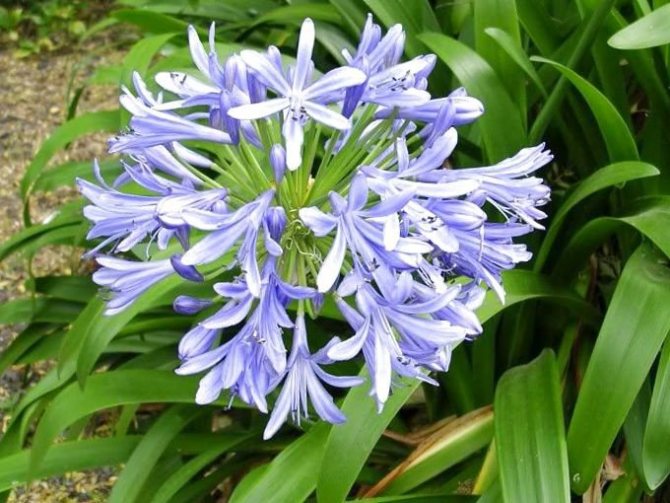
Agapanthus umbrella
African agapanthus. This evergreen plant up to 65 cm tall is suitable for indoor growing. Blue and blue flowers are collected in large umbellate inflorescences. A lighter stripe is visible on the leaves. Known decorative varieties:
- Albus - attracts with a large snow-white inflorescence;
- Albus Nanus - dwarf (up to 40 cm) variety with white flowers;
- Albidus is a plant with white perianths on which a red spot is located;
- Variegata is a tall plant with a white stripe along the leaf plate.
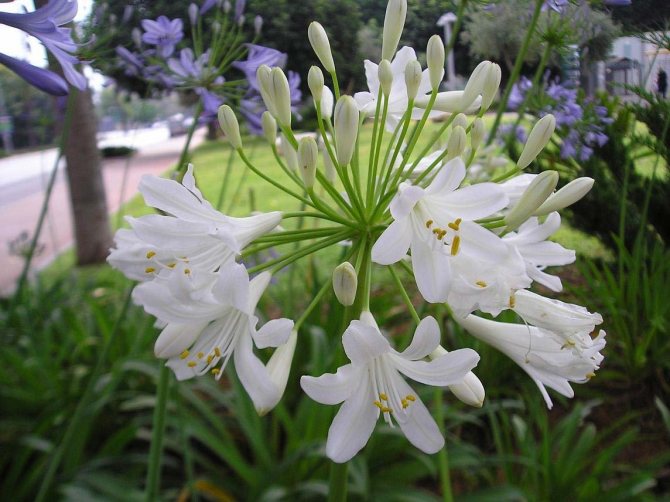

African agapanthus
Agapanthus is bell-shaped. Miniature graceful plant with narrower foliage. The length of the leaves does not exceed 15 cm. For the winter, the foliage falls off. The flowers are blue-violet and bloom in July-August.
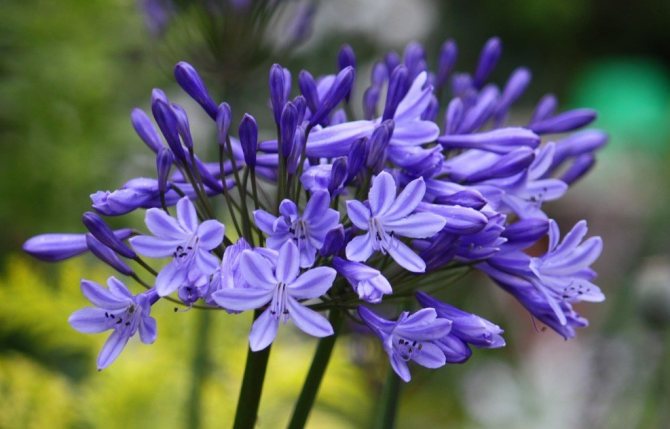

Agapanthus bell-shaped
Eastern agapanthus. The evergreen plant forms a dense curtain up to 40 cm in diameter. The leaves are wider and shorter. On peduncles up to 60 cm long, delicate purple flowers are located.
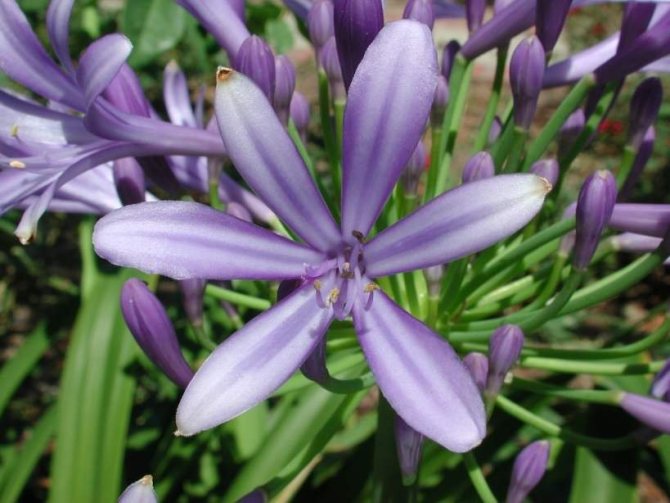

Eastern agapanthus
Bloom
During the flowering period of agapanthus, a long peduncle grows from a leaf outlet. The inflorescence has an umbrella shape. The flowers are funnel-shaped, white, blue and lilac shades. The opening of the flowers occurs gradually. The flowering period is approximately two months.
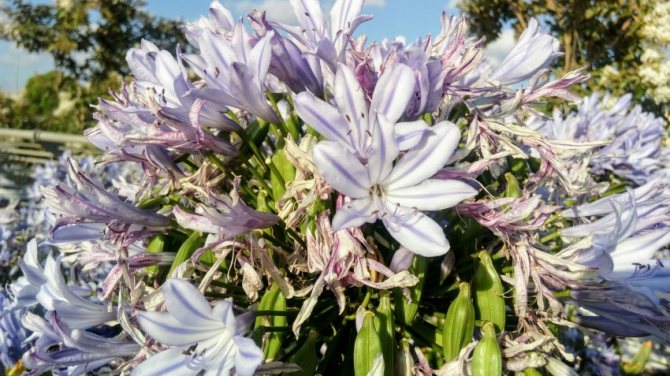

How to make agapanthus bloom? Possible reasons for the plant not blooming include the following:
- improperly selected pot;
- an excess of nitrogen-containing and organic fertilizers in the soil;
- improper fit;
- the wrong temperature during the wintering period.
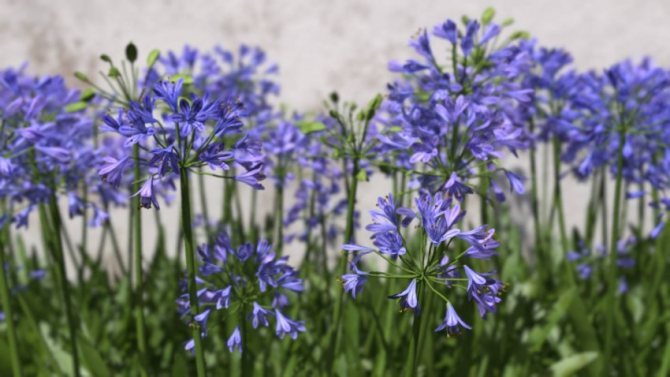

In order for a flower to bloom, it is necessary to remove the corresponding root cause.
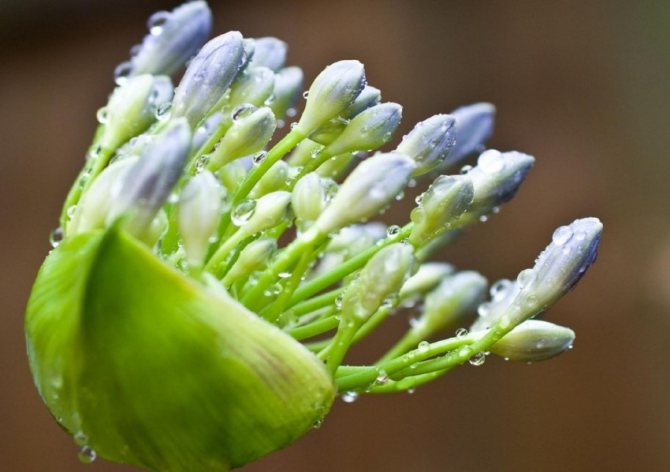

Reproduction methods
Reproduction of agapanthus can be carried out by sowing seeds or dividing the bush. The seed method will seem to many to be too extended in time, because seedlings bloom after 5-7 years. In addition, there is a possibility of over-pollination and loss of varietal traits. Sowing seeds for seedlings is carried out in early March. Use small greenhouses in the form of boxes with a sand-peat soil mixture. The soil is moistened and seeds are sown in shallow holes. The greenhouse is covered with foil, but aired every day for about half an hour. The optimum air temperature is + 16… + 20 ° C. Seedlings appear within 1-2 weeks. When 4 true leaves grow, the plants can be dived into separate pots.
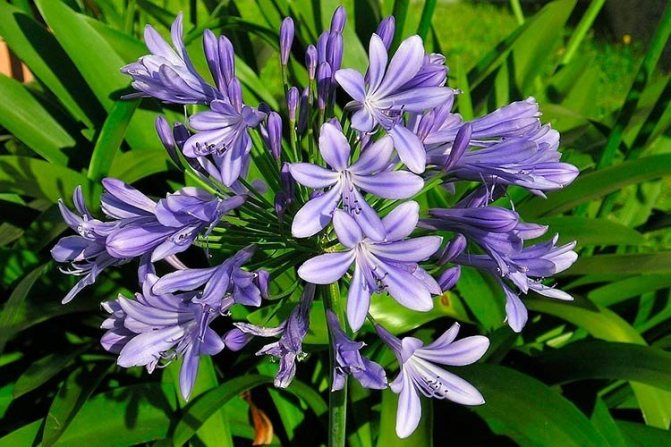

By dividing the bush, you can get several adult plants ready for flowering at once. The procedure is carried out in the fall, when the agapanthus has faded, or in the spring before the formation of peduncles. The bush is dug up and freed from the ground as much as possible. Each section should contain 1-2 sheet sockets. The cut is performed with a sharp, clean knife, and the wounds are sprinkled with activated charcoal. Delenki are not planted immediately, but only covered with a damp substrate for 2-3 days. After that, the agapanthus is planted in a permanent place. Watering the seedlings in the first days you need to little by little.
Growing
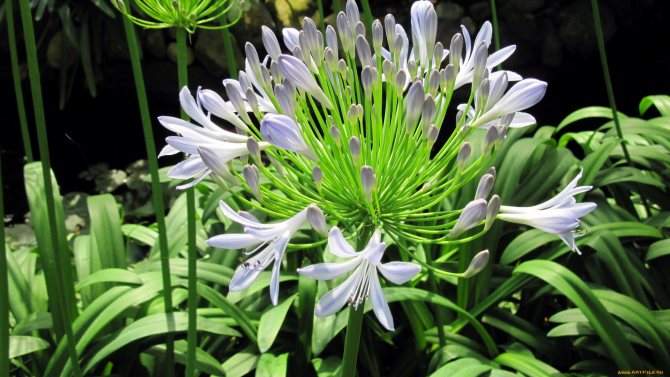

Observing the conditions of maintenance and care, you can grow a wonderful plant. Using Agapanthus seeds, you can get seedlings, however, when growing from seeds, you should be patient, since the first arrow with flowers can only be seen in 5-7 years. Growing a flower using a plot from the mother plant, flowering will be immediately upon planting in the ground.
Reproduction methods


There are three ways of reproduction of Agapanthus: seeds, division of basal rosettes and shoots.
Seeds are planted in early spring. First, they are soaked in cold water for 2 to 3 hours. A wide container or box is prepared, as well as fertilized loose peat soil and drainage. A drainage with a height of 3 - 5 cm is poured at the bottom of the box, then soil is poured, it is well moistened with a sprayer. Shallow pits are made, one seed is placed in each. All are sprinkled with earth and lightly tamped. The box must be covered with cellophane or glass to create a greenhouse effect. 2 - 3 times a day, the covering material is removed for 20 minutes for ventilation. It is necessary to monitor the moisture content of the soil, do not allow it to dry out. After 1-2 weeks, the first shoots will appear from the seeds of Agapanthus, at this stage the covering material is removed.As soon as the fourth leaf grows, the seedlings can be transplanted into separate pots with more fertile soil.
Reproduction by division is carried out in autumn or early spring before flowering. The plant is completely dug up, trying to pick up the roots deeper. Lightly shake off the root system from the ground, and, using a sharp knife, cut off part of the roots with 2-3 basal rosettes. To exclude suppuration of the sections, they are treated - dried and covered with activated carbon. The separated parts are sprayed with water, the roots are wrapped in a damp cloth. In this form, the plant must be kept for several days, and then planted in the ground. In the first days after transplanting, the amount of water for irrigation should be minimal. As soon as the plant takes root and grows, full watering is performed.
In a fairly mature plant, young shoots appear next to the main rosette - daughters, which can be separated and planted as independent plants. Moreover, this method of reproduction requires special care, when separating the seedling from the mother bush, you must try not to damage the roots, otherwise both the seedling and the adult plant may suffer.
Agapanthus transplant


Mature plants do not like frequent replanting. As a last resort, it is recommended to change the location of the bush every 3 years. Young flowers are more tolerant of changing growing locations.
Since the root system of Agapanthus is weak, you should be extremely careful when digging up, the roots may break.
Diseases and pests
The flower is sick due to frequent watering, as a result of which the roots begin to rot, the leaves turn yellow.
In insufficient light, the peduncles are strongly stretched, which can lead to their breakage.
When attacked by scale insects and spider mites, the leaves dry up and fall off. For pest control, soap solution and insecticides are used to treat the affected areas.
Watering
During the entire period of growth and flowering, the plant is watered abundantly, which ensures good flowering. Water stagnation should be avoided, in which case the roots may begin to rot. The flower needs to provide good drainage of the soil. As the temperature drops, the amount of water is reduced. In winter, watering the plant is not required, just make sure that the roots do not dry out.
Agapanthus planting and care in the open field
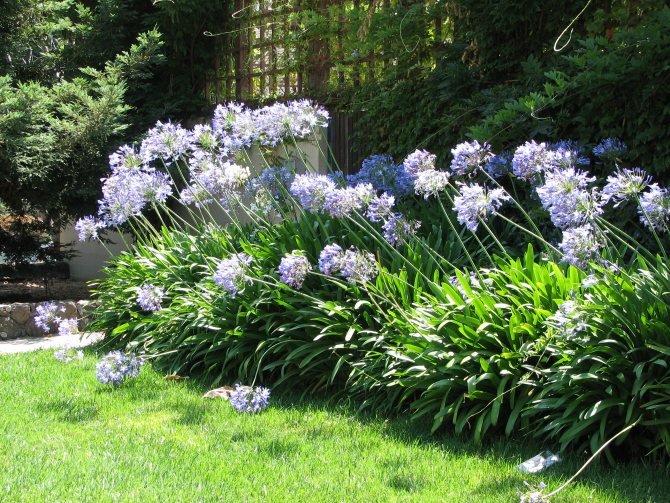

When growing Agapanthus outdoors, a number of rules must be followed.
- Plants need to be planted at a distance of 50 cm from each other, since Agapanthus has lush foliage, it needs a lot of area for comfortable growth. The planting depth of a seedling or a shoot is no more than 10-15 cm.
- Periodically, you need to cut off dried flowers and leaves so that they do not spoil the appearance of the plant.
Agapanthus at home
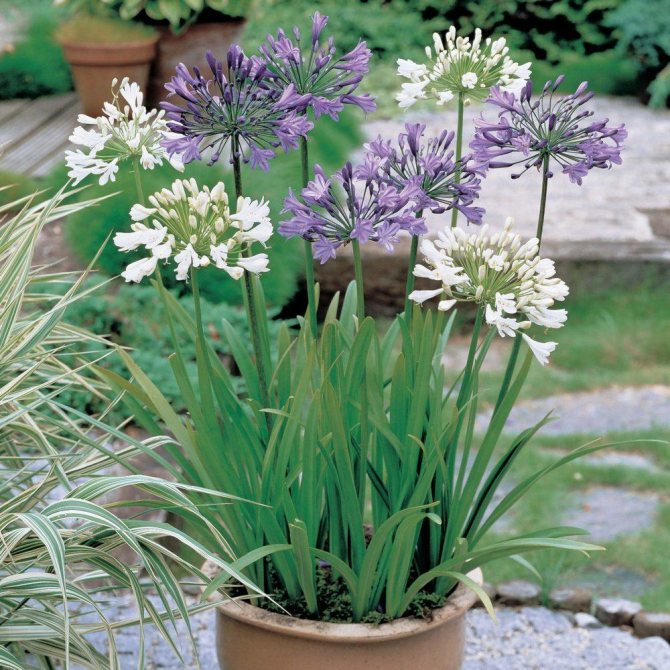

In the cold season in closed rooms, due to the working heating system, the air is dry, but this does not in any way affect the well-being of indoor Agapanthus.
Additional spraying will not hurt the plant, but its absence will not harm the flower. Agapanthus at home gives a lush color only in wide pots with a good drainage system and subject to abundant watering, periodic fertilizing. Perennial Agapanthus is one of the favorite ornamental plants among gardeners.
Abundant green dense foliage, tall peduncles, lush bright flowers can decorate any flower bed or flower garden. Many people use Agapanthus flowers in floristry. The beneficial antiviral properties of rhizomes are widely used in traditional medicine.
Care rules
Caring for agapanthus requires a certain skill, only in this case it will appear in all its glory. It is not even regular procedures that are more important, but the selection of the right place for the flower. Agapanthus needs intense lighting and a long day of light.With a lack of light, the leaves begin to fade, and the flower stalks stretch out strongly. Thin stems can even break off. From May, it is recommended to take the pots out into the open air in direct sunlight. Here, the leaves are not even afraid of intense heat. Moderate drafts do not frighten agapanthus either.
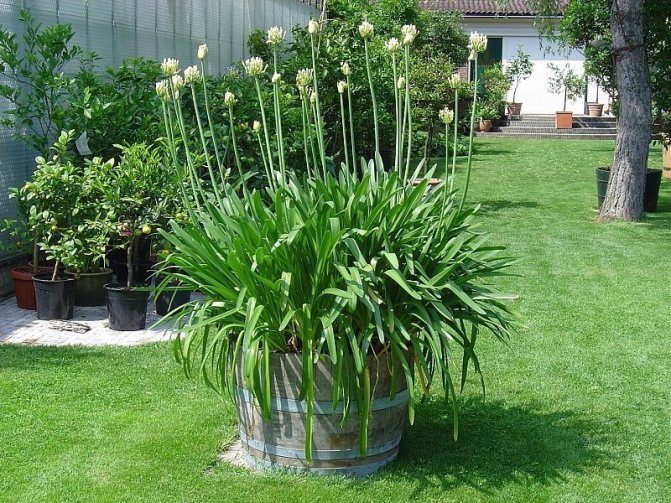

The optimum air temperature for the African lily is + 25 ... + 28 ° C. From September, you should begin to lower the temperature and provide the plant with a cold winter. Evergreens hibernate at + 12 ... + 15 ° C. + 5 ° C is sufficient for deciduous species.
In the southern regions, agapanthus is grown outdoors. But even in warm winters, he needs a shelter made of nonwoven fabric and fallen leaves. To the north, the African lily is grown as an annual or dug up and stored indoors for the winter.
Agapanthus needs high humidity. It is recommended to spray it daily with a spray bottle and wash it regularly under a warm shower. It is necessary to use soft water so that no ugly lime stains remain on the juicy leaves. They try not to wet the flowers, otherwise they will quickly fade.
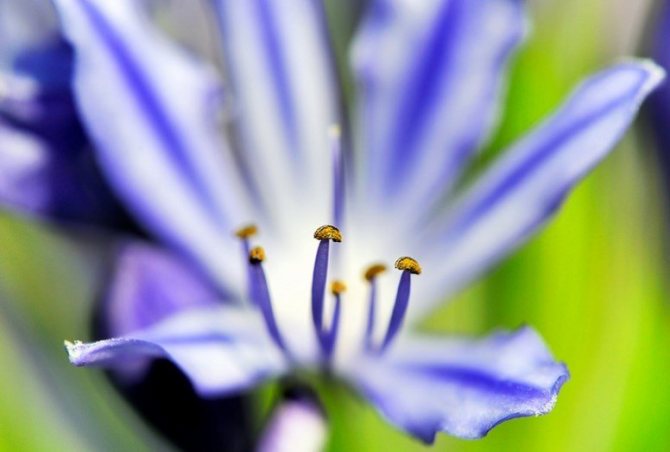

Agapanthus should be watered abundantly and often during the active growing season. Stagnation of water in the ground is unacceptable, therefore, care should be taken to ensure good drainage. In order for the air to penetrate to the roots, it is recommended to periodically loosen the soil. As the air temperature decreases, irrigation is reduced and by winter they switch to weak soil moisture. From the end of March until the end of flowering, fertilizers must be applied under the agapanthus. Mineral complexes for flowering and organic matter alternate. Top dressing is heavily diluted with water and applied twice a month. With the onset of cold weather, the plant completely ceases to be fertilized.
To make the crown look neat, it is necessary to remove yellowed leaves and wilted flower stalks. The plant does not need molding pruning.
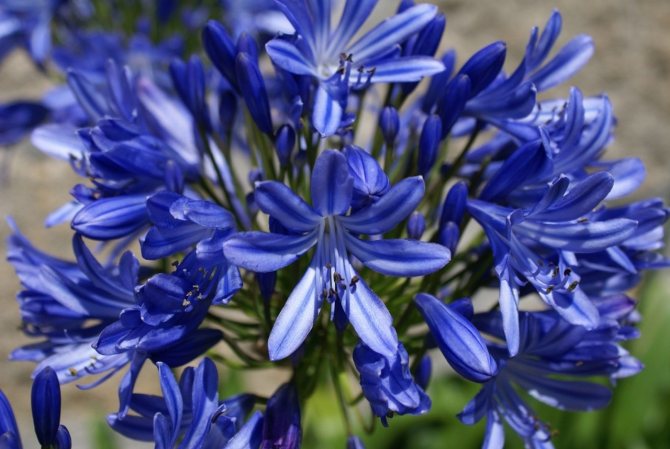

How to plant and care
The issue of planting and caring for agapanthus with your own hands requires especially careful study. For a flower to feel good, you need to create a certain microclimate. Proper lighting is essential.
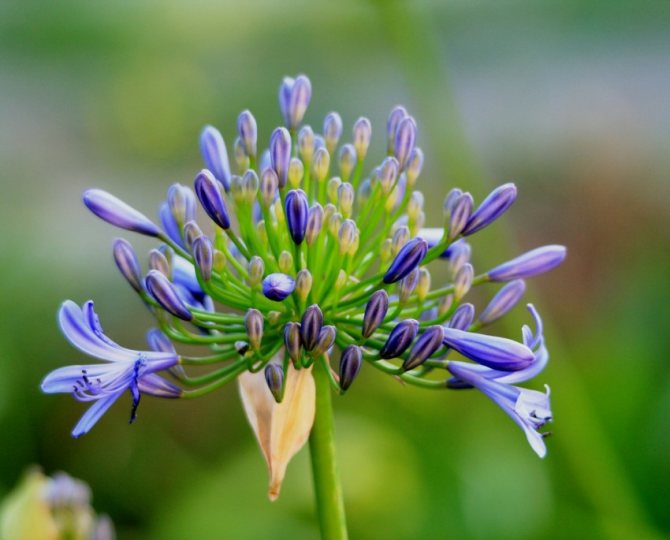

Insufficient illumination has a detrimental effect on the flower - it loses its strength and becomes brittle. In addition, you need to provide warmth, slightly acidic (possibly neutral) soil and moderate watering.
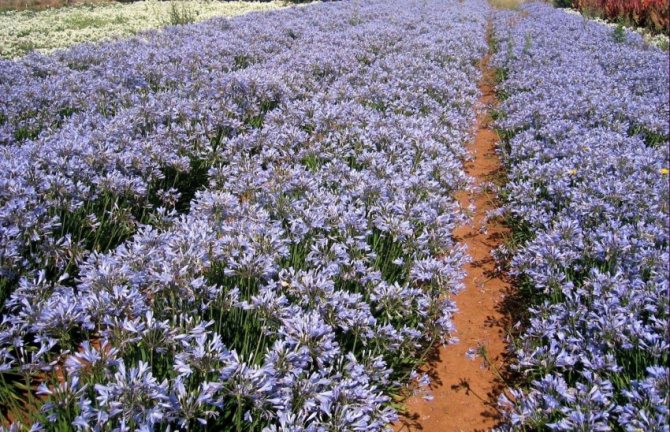

Flower transplant
Agapanthus needs to be replanted every 2-3 years. Unlike most flowering plants, it needs a spacious pot. In a cramped container, flowering will be weak or stop altogether. At the bottom, it is necessary to pour 2-3 cm of drainage material. The soil should be slightly acidic and sufficiently nutritious. You can use the following composition:
- humus earth;
- clay-sod land;
- leafy land;
- sand.
When transplanting, the roots are partially freed from the old soil. It is recommended to periodically mulch the top layer with peat and turf to prevent drying out.
Agapanthus meaning
What is the purpose of the plant. Such a flower will be a wonderful decoration for any window sill, terrace, balcony. But always remember to have adequate lighting.
To summarize: in order to achieve a constant neat appearance of the plant, it is necessary to collect outdated foliage in a timely manner, preferably before the formation of a new leaf cover. The container is recommended to be selected from a wooden material, for example, a small tub, barrel or box. Ceramic dishes have the ability to burst under strong pressure from rapidly growing roots. But the most important feature of a flower is the release of a special phytoncide substance into the air space. It is this substance that helps in the fight against the virus and numerous infections.
African lily landscape
Agapanthuses are very popular among landscape designers for their appearance and unpretentiousness.They look elegant and original on plots of various sizes, decorating courtyards and gardens with their lush flowering. The sizes and colors of these colors are varied, but designers prefer not to combine them with other colors, agapanthus are self-sufficient.
However, on large areas, original combinations are possible. They look great along curbs and various bodies of water, attracting a lot of butterflies and birds. Agapanthus early, variety "Pale ball" (Agapanthus Praecox Pallidus) in the landscape They are also valued for long flowering, which allows you to maintain the beauty and splendor of the yard for a very long time.
general information
Agapanthus is a herbaceous perennial belonging to the family of the same name. Its native plant is southern Africa, where it grows along the sea coast and on the slopes of the mountains and is widely known as the African lily.
The plant has a Greek name, which means "favorite flower".
Description
Agapanthus has a short, branched creeping rhizome and rosette leaves, often with a thickened surface.
Its flowers are unusual in shape and represent an umbrella-shaped inflorescence carried by a long (up to a meter) peduncle. The inflorescence is formed by several hundred small, funnel-shaped and elongated flowers, painted in white, blue, purple and blue shades. Each flower resembles a miniature lily.
Value
Agapanthus inflorescences are good for cutting. Due to the gradual disclosure, they retain their decorative effect for a long time, without losing it even after drying.
The flower is useful in that it is able to purify and disinfect the air, absorbing vapors of heavy metals from it and releasing phytoncides.
Useful video
Watch a video about the features of the African Agapanthus:
Other types of flowering plants are no less remarkable, a detailed description of which can be found in our articles. Read about fabulous strelitzia, original akalifa, velvet coleria, amazing gerbera, delicate clerodendrum, unpretentious fuchsia, medicinal cyclamen, cheerful petunia and evergreen azalea.
History and appearance
Natural varieties were discovered more than a century ago on the mountain slopes of Africa in the Cape Province. This climate assumes slight frosts, therefore, hybrid varieties bred by modern breeders, tolerate a slight decrease in temperature. In European countries, agapanthus is grown in open ground, covering with a light shelter for the winter.
Perennial Agapanthus has a fleshy rhizome... Leaves are dense, belt-shaped, grow to an average of 50-70 cm in length. The leaves are connected at the rhizome with a basal rosette. Agapaanthus is distinguished by its lush, rich foliage of saturated bright green color. On a long peduncle, inflorescences are collected - bouquets of delicate shades of purple, blue, lilac. Usually blooms in mid-summer, flowering is long, lasts until mid-September. Agapaanthus African is popular in domestic floriculture, it is more adapted to our climate.
Top dressing
To get a truly lush flower garden in front of the house, it is important to regularly feed agapanthus. During budding and flowering, feed the bushes every two weeks. Moreover, it is desirable to alternate organic and mineral fertilizers. Then the plant will receive all the necessary elements and nutrients.
From organic matter, use humus, peat, ash or compost. From mineral fertilizers, choose formulations intended for indoor flowering plants. Apply top dressing from spring to late summer.
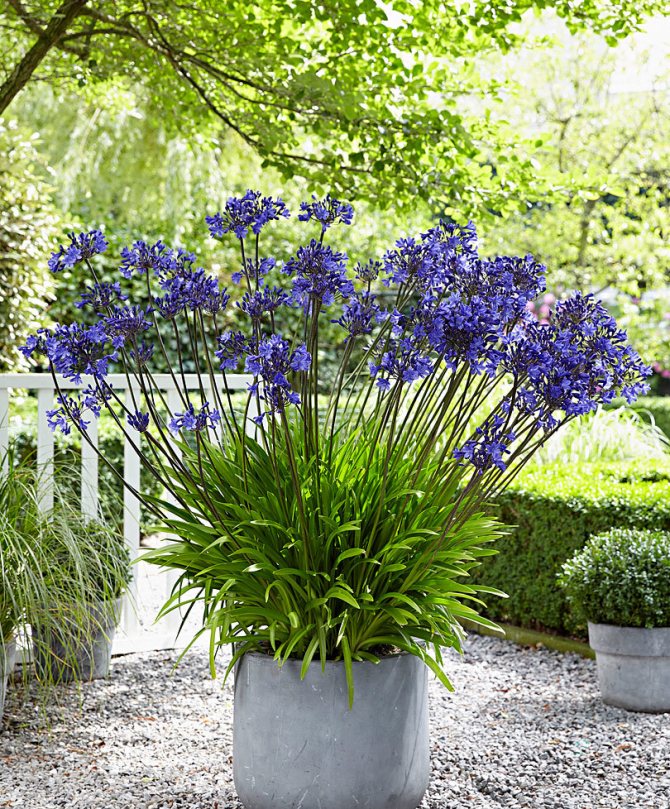

Landing
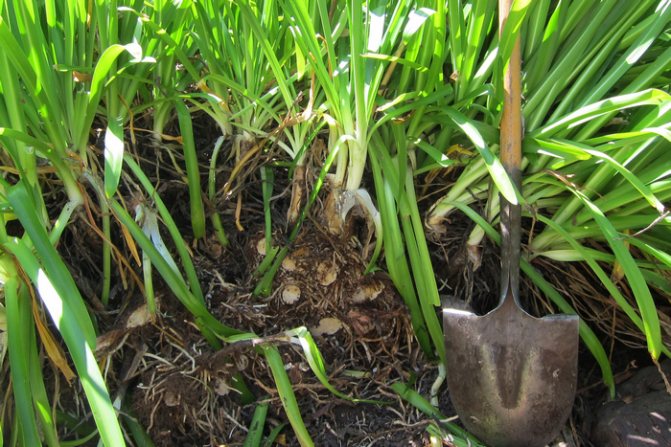

In March, the condition of the roots is checked. Agapanthus is transplanted in case of emergency. If possible, the top backing layer can be replaced. If transplanted too early or in a large pot, there will be little or no flowering. The pot must be one size larger. Transplanted into slightly acidic open ground, rich and quite airy.The acquired soil is enriched by adding compost soil and vermiculite. In the absence of compost, nothing special will happen. Vermiculite or perlite is sold in every gardening store, vermiculite prevents the requirement of soil and improves air circulation around the roots. For best flowering, plants need to be split every 4 years.
Main types
Eastern agapanthus (Agapanthus orientalis)
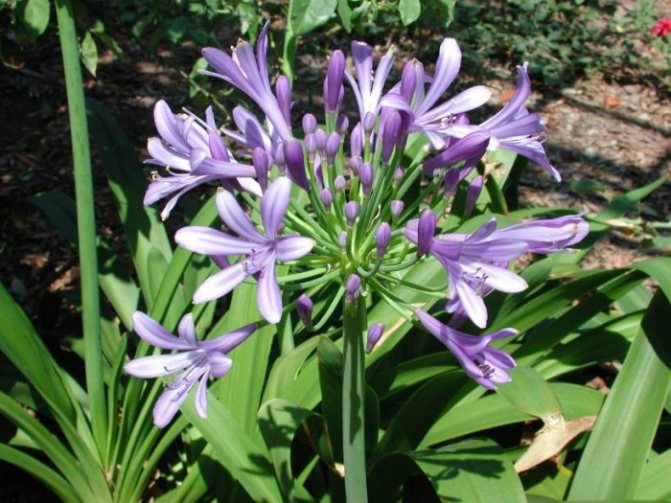

It is a perennial evergreen herb native to South Africa. Thick, wide, curved leaves have a linear shape. The peduncle can reach a height of up to half a meter. About 100 flowers can grow on an umbrella-shaped inflorescence. Flowering occurs in the middle and late summer.
Agapanthus umbellatus (Agapanthus umbellatus)
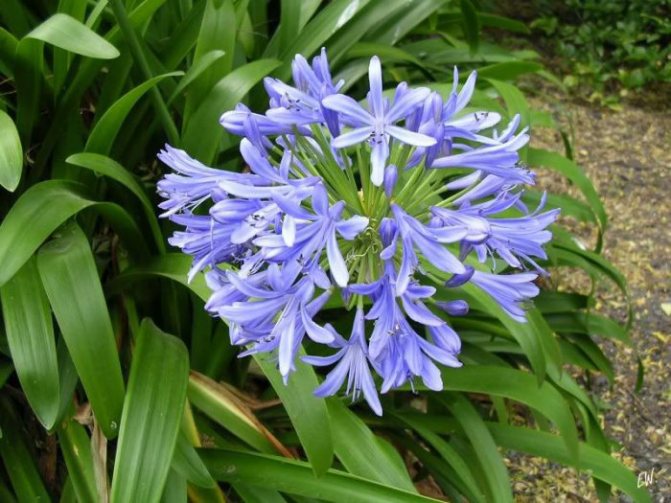

It is also called the Abyssinian beauty or African lily (agapanthus africanus). This herb is native to South Africa. It can reach a height of 70 centimeters. Smooth, grooved, dark green leaves grow from the root rosette and have a belt-like shape. The leaves taper towards the apex. The peduncle is quite long and has umbellate inflorescences on it, which consist of many funnel-shaped bluish flowers. Each flower has 6 petals, which have grown together at the base. Such a plant blooms in the beginning and middle of the summer period. After 40 days after the end of flowering, the seeds of the agapanthus fully ripen.
Description and characteristics of agapanthus
The life span of agapanthus is quite long, in most varieties it is evergreen, has an elongated peduncle and exotic leaves, which are somewhat reminiscent of the leaves of a yellow daylily, which has long been widely used for decorative purposes.
The plant has a characteristic, rather fleshy, short root, thick stem (the flower reaches a height of one and a half meters). The flowering time is long, up to 2 months.
About 30 funnel-shaped flowers are collected in inflorescences (diameter - 30-45 mm) in the shape of an umbrella of delicate colors - from blue-purple to milky white, have 6 petals, stamens with brown pollen. Flowering peaks in July and ends at the end of August. Agapanthuses grow in large groups, being native to Africa, they perfectly tolerate the hot climate, but the cold below (+ 10 ° C) is destructive for them.
Agapanthus Legend
It is no secret that the spiritual world of a person is closely connected with flowers. Despite the fact that every nation perceives beauty in its own way, everyone perceives the beauty of flowers in the same way. Hence, there are numerous legends, including about Agapanthus, which says that in ancient times there lived an Abyssinian girl named Agapa. She was very beautiful and lived with faith in Christ. It was for this that she suffered. Her tribesmen brutally dealt with the girl, and at the place of her death a sky-blue Agapanthus flower appeared, which became a symbol of purity and purity.
Reproduction of agapanthus by dividing the bush
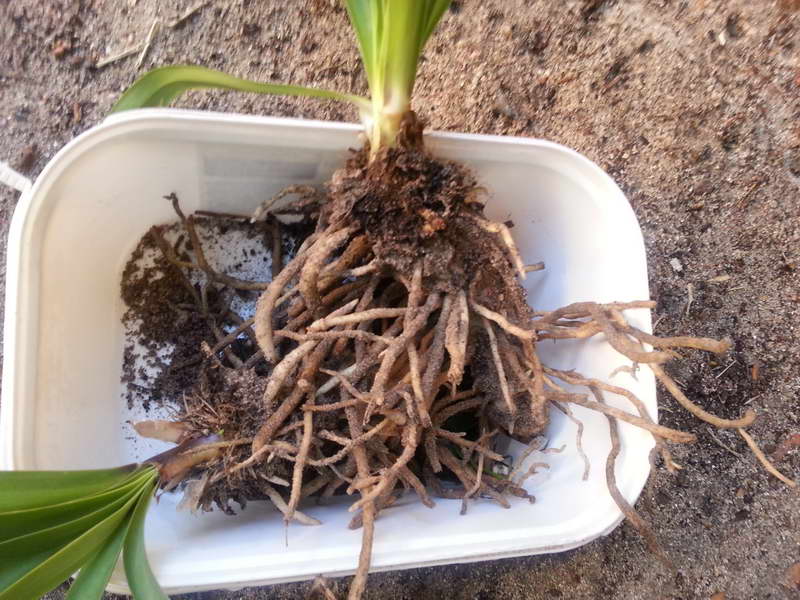

How to split an agapanthus bush photo
Agapanthus is propagated vegetatively by dividing the rhizome.
- The procedure for dividing the bush is carried out during the spring transplant.
- You can divide adults, well-grown bushes (with a frequency of 3-4 years).
- Take large plots, each of which should have a formed root system and growth buds.
- If the cuttings are small, they will take root for a long time and grow, respectively, flowering will come much later.
Landing is described earlier. Charcoal can also be added to the planting hole.
Popular varieties
Of the whole variety of agapanthus varieties, the following are especially popular among Russian gardeners:
- Variegata. It is distinguished by a high peduncle and sky-blue petals, on which there are white stripes.
- Albus. Its snow-white peduncles reach 25 cm in diameter.
- Peter Pan. A dwarf variety with a height of 35–40 cm. Sky blue bells.
- Star Quality. The peduncle reaches 100 cm in height.The buds are painted in cream, lilac and blue tones. The variety is suitable for cutting and stands fresh for up to 16 days.
- Pinocchio. Peduncles of the variety reach 80 cm in length. The petals are painted in a bright indigo color. Easier to take root in the apartment than in the open field.
Each of these varieties will adorn your flower collection. But for this it will be necessary to provide the culture with good conditions.



